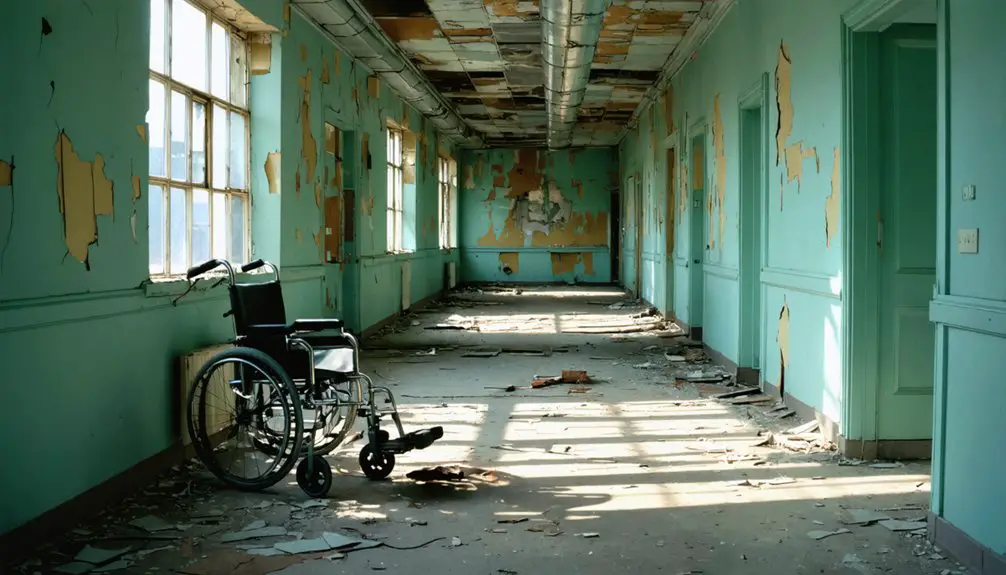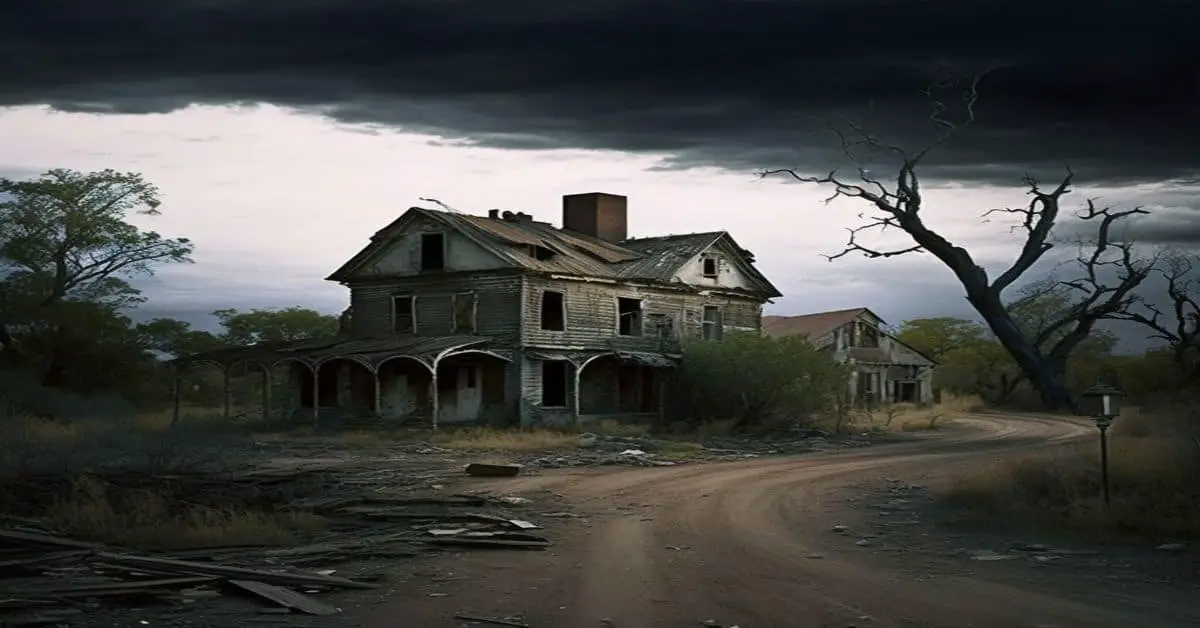You’ll find Glenn Dale Hospital‘s haunting 216-acre campus in Maryland, where 23 Colonial Revival buildings stand frozen in time since its closure in 1982. As America’s largest abandoned tuberculosis sanatorium, the facility once housed 600 patients and 500 staff members, featuring innovative fresh-air treatment spaces and underground tunnels connecting its wards. While deteriorating behind chain-link fences today, this historic medical complex holds countless untold stories within its crumbling brick walls.
Key Takeaways
- The abandoned Glenn Dale Hospital complex spans 200 acres with 23 buildings, featuring Colonial Revival architecture and underground tunnel systems.
- Built in 1934 as a tuberculosis sanatorium, the facility operated until 1982 and housed up to 600 patients at peak capacity.
- The hospital’s structures suffer from severe deterioration and contain hazardous materials like asbestos, making exploration extremely dangerous.
- Maryland law strictly limits future development to continuing care retirement facilities, complicating preservation and redevelopment efforts.
- The site earned National Register of Historic Places status and maintains strong community support for preservation through local advocacy groups.
The Rise of a Historic Tuberculosis Sanatorium
When tuberculosis ravaged the Washington, DC area in the early 1930s, Glenn Dale Hospital emerged as a beacon of hope for those afflicted by the deadly disease.
Built in 1934, this sprawling 216-acre sanatorium represented a revolutionary public health response to combat the tuberculosis stigma that had previously forced patients into inadequate facilities where they were left to die.
You’ll find the sanatorium’s evolution reflected in its 23 carefully designed buildings, connected by underground tunnels and featuring rooftop gardens.
Located 15 miles from DC, the facility embraced the era’s treatment philosophy of fresh air and sunlight.
While early treatment options were limited, Glenn Dale offered something precious to its patients – specialized care and a chance at survival in an age when tuberculosis meant certain death to many.
The hospital’s opening in September 1937 brought immediate relief as 225 patients were transferred from the overcrowded facility at Upshur Street.
The facility reached its peak capacity with 600 patients and 500 staff members working tirelessly to provide care and treatment.
Colonial Revival Architecture and Campus Design
The architectural grandeur of Glenn Dale Hospital reveals itself through seventeen Colonial Revival buildings constructed between 1933 and 1959.
You’ll find classical elements like symmetrical façades, elaborate door surrounds, and Georgian Revival brickwork defining these structures across the 216-acre campus.
As you explore the grounds, you’ll notice how the campus aesthetics were carefully planned around therapeutic principles.
Buildings were strategically positioned to maximize sunlight and fresh air exposure – vital elements in tuberculosis treatment.
The sprawling layout features interconnected pathways linking medical facilities, staff residences, and support buildings, while underground tunnels offered protected passage during bad weather.
Expansive lawns and woodland buffers create a sense of isolation, with service buildings thoughtfully placed along the periphery to maintain the peaceful, healing environment.
Notable architects Albert L. Harris helped establish the hospital’s distinctive architectural character through thoughtful design choices.
The property is currently owned by the Maryland-National Capital Park and Planning Commission who maintains oversight of the historic campus.
Life Behind Hospital Walls: Patients and Staff
Behind the stately Colonial Revival façades, Glenn Dale Hospital’s walls contained a complex microcosm of human experiences shaped by tuberculosis treatment and isolation.
Patient experiences were defined by strict regimentation in dormitory-style wards, where up to 600 individuals lived separated from the outside world, often indefinitely. The stigma was so severe that families hid diagnoses from friends and neighbors, deepening the sense of isolation. Treatment focused heavily on providing patients with fresh air therapy in sunlit rooms and outdoor areas.
Staff challenges included managing both physical care and emotional support for those facing what many considered a death sentence.
Key aspects of life within Glenn Dale’s walls:
- Doctors and nurses worked tirelessly among 500 specialized staff members, fighting TB with limited medical knowledge.
- Patients endured both physical quarantine and psychological isolation, with minimal family contact.
- Daily routines centered on fresh air therapy and rest, reflecting the era’s best-known treatment methods.
Public Health Impact During the TB Crisis
When you look at Glenn Dale Hospital‘s public health strategies during the TB crisis, you’ll find they relied heavily on isolation and fresh-air treatment protocols that were standard before antibiotics became available.
The hospital’s 23-building campus, strategically placed 15 miles outside Washington D.C., allowed staff to segregate patients by age and disease stage while providing specialized care that helped reduce overcrowding in urban hospitals.
As the largest regional employer and treatment center of its kind, Glenn Dale served patients from D.C., Maryland, and Virginia, making it an essential hub in containing the spread of tuberculosis throughout the mid-Atlantic region. The facility provided free medical care to tuberculosis victims, ensuring treatment access regardless of economic status.
Disease Control Methods Used
Three key disease control strategies shaped Glen Dale Hospital’s response to the tuberculosis crisis: environmental design, strict isolation protocols, and evolving medical treatments.
You’ll find these methods reflected in the hospital’s sprawling 216-acre campus, where 23 buildings maximized patients’ exposure to fresh air and sunlight.
The hospital’s all-encompassing approach to disease control included:
- Environmental therapies through rooftop gardens and solariums
- Strict quarantine measures separating TB patients from the public
- Progressive medical treatments, shifting from rest-based care to antibiotic therapy after 1943
When weather permitted, you’d see patients moving between buildings outdoors to limit transmission risks.
Underground tunnels existed but were used sparingly, as the focus remained on leveraging natural elements like sunlight and fresh air to strengthen patients’ recovery.
Patient Care and Isolation
As tuberculosis ravaged Washington D.C. in the 1930s, Glenn Dale Hospital emerged as a fortress of isolation, implementing strict patient segregation across its 23-building campus.
You’d find patients carefully separated in different buildings connected by underground tunnels, though outdoor movement was encouraged whenever possible to reduce infection risks.
Patient treatment initially focused on rest, fresh air, and sunlight exposure in the hospital’s Colonial Revival buildings.
After 1943, you’d see a shift toward active antibiotic therapies with streptomycin, though staff shortages limited treatment effectiveness.
The emotional effects were devastating – TB diagnosis often meant social death, with patients facing family abandonment and community ostracism.
While isolation helped control the disease’s spread throughout D.C., it came at a heavy psychological cost to those confined within Glenn Dale’s walls.
Regional Healthcare System Impact
During the tuberculosis crisis of the 1930s, Glenn Dale Hospital emerged as a critical anchor in Washington D.C.’s public health infrastructure.
You’ll find it served as more than just a treatment center – it revolutionized regional healthcare by tackling systemic barriers head-on. Breaking with era norms, the facility championed healthcare equity by treating both Black and white patients. The hospital was strategically placed at a location distant from populations to prevent disease spread.
The hospital’s impact on regional TB control was profound in three key ways:
- Modernized treatment delivery through its 23-building campus design
- Reduced community transmission by providing dedicated isolation spaces
- Established a model for integrated care that influenced other facilities
The Haunting Legacy and Urban Legends
While Glenn Dale Hospital served as a tuberculosis sanatorium from 1934 to 1982, its abandoned halls now echo with something far more sinister in local folklore.
The 23-building campus has become a magnet for haunting narratives, with tales of restless spirits of tuberculosis patients and mysterious figures lurking in decaying corridors. You’ll hear whispers of “The Goatman” prowling nearby woods and urban folklore about inhumane experiments, though official records dispute these claims. Located 15 miles from D.C., the isolated setting adds to its eerie atmosphere.
The hospital’s architectural features – sprawling solariums, isolated treatment rooms, and an on-site morgue – fuel these supernatural stories.
The facility’s grim history as a place where many spent their final days, combined with its current state of ivy-covered decay, continues to captivate paranormal enthusiasts and shape local mythology.
Preservation Challenges and Future Vision

Despite its historical significance, Glenn Dale Hospital faces mounting preservation hurdles that threaten its future. The property’s decades-long abandonment since 1981 has led to extensive structural deterioration, while hazardous materials like asbestos and lead paint complicate preservation strategies.
You’ll find the site’s 20+ historic structures spread across 200 acres presenting significant logistical challenges. A recent Beyer Blinder Belle assessment confirmed the buildings remain structurally sound despite years of neglect.
Key preservation obstacles include:
- Maryland law restricting future use to continuing care retirement facilities
- Lack of historic preservation easements limiting protection options
- Failed property sales due to bidder non-compliance with licensing requirements
Yet there’s hope through strong community involvement. Local civic associations and Preservation Maryland have rallied nearly 500 supporters since 2014, pushing for transparent redevelopment plans while maintaining pressure for funding and regulatory approvals needed to save this historic campus.
Historical Significance in Modern Times
Throughout its 47-year operational history, Glen Dale Hospital stands as a tribute to America’s evolving approach to public health crises and institutional medical care.
You’ll find its significance deeply woven into modern healthcare practices, representing a vital chapter in the fight against tuberculosis that shaped today’s infectious disease protocols.
The hospital’s architectural preservation tells a powerful story of public health innovation, from its strategic rural location to its specialized treatment facilities.
What you’re witnessing in Glen Dale’s Georgian Revival buildings isn’t just historic architecture – it’s a symbol of how society mobilized against a deadly epidemic.
Listed on the National Register of Historic Places, the complex serves as a reminder of healthcare’s transformation from isolation-based treatment to today’s advanced medical solutions.
Frequently Asked Questions
What Are the Exact Coordinates of the Hospital’s Main Entrance?
You’ll find the historically significant hospital’s main entrance at exactly 38.96083°N, 76.81333°W, which matches the official records for this abandoned location in Glenn Dale, Maryland.
How Many Patients Died at Glenn Dale Hospital During Its Operation?
You won’t find an exact count of patient mortality at Glenn Dale, as historical records aren’t publicly available. While thousands likely died during its 45+ years treating tuberculosis, precise numbers remain undocumented.
Were Any Experimental Treatments or Medical Research Conducted at Glenn Dale?
You won’t find evidence of experimental treatments at Glenn Dale – they mainly followed standard TB protocols and adopted proven therapies like streptomycin as they emerged in medical history, rather than conducting original research.
What Happened to Patient Records and Medical Equipment After Closure?
Deserted desks and damaged documents tell the tale: you’ll find patient records were likely moved to state archives, protecting privacy, while medical equipment’s fate remains unclear after the hospital’s hasty 1981 closure.
Did Any Famous or Notable People Receive Treatment at Glenn Dale?
You won’t find any documented celebrity patients at Glenn Dale. While thousands received notable treatments there during the TB epidemic, records don’t reveal any famous individuals among those treated.
References
- https://en.wikipedia.org/wiki/Glenn_Dale_Hospital
- https://preservationmaryland.org/project/glenn-dale-hospital-breathing-new-life-into-old-buildings/
- https://wtop.com/entertainment/2015/10/ghost-tales-inside-glenn-dale-hospital/
- https://www.atlasobscura.com/places/glenn-dale-hospital
- https://apps.mht.maryland.gov/nr/NRDetail.aspx?NRID=1600
- https://boundarystones.weta.org/2015/02/10/dcs-tb-problem
- https://www.rmsarchitecture.com/glenn-dale-village-community
- http://kathrynknightbooks.blogspot.com/2017/10/the-abandoned-glenn-dale-tb-hospital.html
- https://www.fabledcollective.com/glenn_dale/
- https://www.historic-structures.com/md/glenn_dale/glenn-dale-tuberculosis-sanatorium/



